Some chemical tags on DNA, called epigenetic factors, that are present at a young age can affect the maximum life spans of mammal species.
Category: genetics – Page 86
As Vertex and CRISPR Therapeutics’ exa-cel and Verve Therapeutics’ VERVE-101 move forward, questions remain about possible drawbacks of such therapies.
Humans and other mammals can produce a wide range of sounds, while also modulating their volume and pitch. These sounds, also known as mammalian vocalizations, play a central role in communication between both animals of the same and of different species.
Researchers at Stanford University School of Medicine recently carried out a study aimed at better understanding the neural mechanisms underpinning the production and modulation of mammal vocalizations. Their paper, published in Nature Neuroscience, identifies a neural circuit and a set of genetically defined neurons in the mouse brain that play a key role in the production of sound.
“All mammals, including humans, vocalize by pushing air past the vocal cords of the larynx, which vibrate to produce sound,” Avin Veerakumar, co-author of the paper, told Medical Xpress.
Many Black Americans who are thought to have a high risk of developing kidney disease possess a protective genetic variant that nullifies the extra risk, a new study from Columbia researchers has found. The work is published in the journal Nature Communications.
The study found that high-risk people who carry this variant have a risk of developing kidney disease much closer to that of the general population.
The findings will have an immediate impact on clinical practice, says study leader Simone Sanna-Cherchi, MD, associate professor of medicine at Columbia’s Vagelos College of Physicians and Surgeons.
Researchers at the Francis Crick Institute, UCL, and MSD have identified a potential treatment target for a genetic type of epilepsy.
Developmental and epileptic encephalopathies are rare types of epilepsy that start in early childhood. One of the most common types of genetic epilepsy, CDKL5 deficiency disorder (CDD), causes seizures and impaired development. Children are currently treated with generic antiepileptic drugs, as there aren’t yet any disease-targeting medications for this disorder.
CDD involves losing the function of a gene producing the CDKL5 enzyme, which phosphorylates proteins, meaning it adds an extra phosphate molecule to alter their function. Until now, researchers have not been sure how genetic mutations in CDKL5 cause CDD.
Introduction to spatial genomics The power of single-cell resolution Mapping the blueprint of health Case study: Bio-Techne Challenges and future prospects References Further reading
Spatial genomics is a cutting-edge field that combines genomics and spatial analysis to investigate the role of genomic features in disease at single-cell resolution.
Spatial genomics is a field of study that focuses on analyzing the spatial organization of genomic features within intact tissues. It involves the simultaneous analysis of various molecular components, including genomic DNA and RNA, through transcriptomic analysis and epigenetic modifications within their spatial context. These techniques aim to reveal the spatial relationships between the different genomic elements and provide insights into the organization and function of single cells within tissues, enabling the molecular connection of a particular genotype to its phenotype.
Researchers at the Francis Crick Institute, UCL and MSD have identified a potential treatment target for a genetic type of epilepsy.
Developmental and epileptic encephalopathies are rare types of epilepsy that start in early childhood. One of the most common types of genetic epilepsy, CDKL5 deficiency disorder (CDD), causes seizures and impaired development. Children are currently treated with generic antiepileptic drugs, as there aren’t yet any disease-targeting medications for this disorder.
CDD involves losing the function of a gene producing the CDKL5 enzyme, which phosphorylates proteins, meaning it adds an extra phosphate molecule to alter their function. Until now, researchers have not been sure how genetic mutations in CDKL5 cause CDD.
Join us on Patreon! https://www.patreon.com/MichaelLustgartenPhDDiscount Links: Epigenetic, Telomere Testing: https://trudiagnostic.com/?irclickid=U-s3Ii2r7x…
A team of scientists used gene editing to create what they thought would be a calmer rodent. Instead, the gene-edited rodents were angrier.
Dr. David Sinclair presents about the new update on epigenetic reprogramming on reversing aging to prevent and treat rare and common diseases in this video.









